作者:赵俊 发布日期:2019/10/18
一、第一个python程序
1、在解释器下写hello world程序运行,与运行外部文件方法
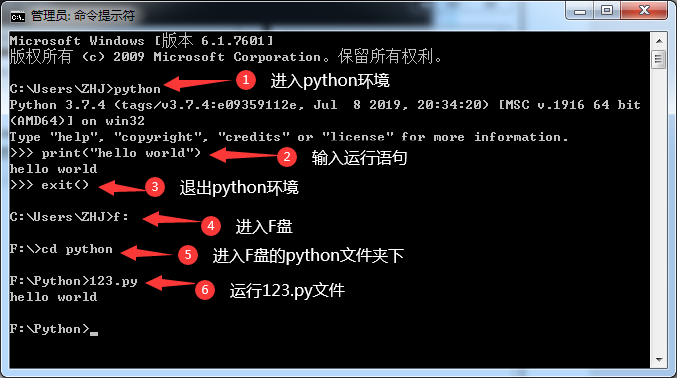
运行外部文件,必须在相应位置创建一个python文件,里面写上语句
2、#!/usr/bin/evn python的作用,告诉操作系统使用的解释器是什么
#!/usr/bin/python相当于写死了python路径;
#!/usr/bin/env python会去环境设置寻找python目录,推荐这种写法
二、变量
1、pycharm工程新建文件,模板代码设置
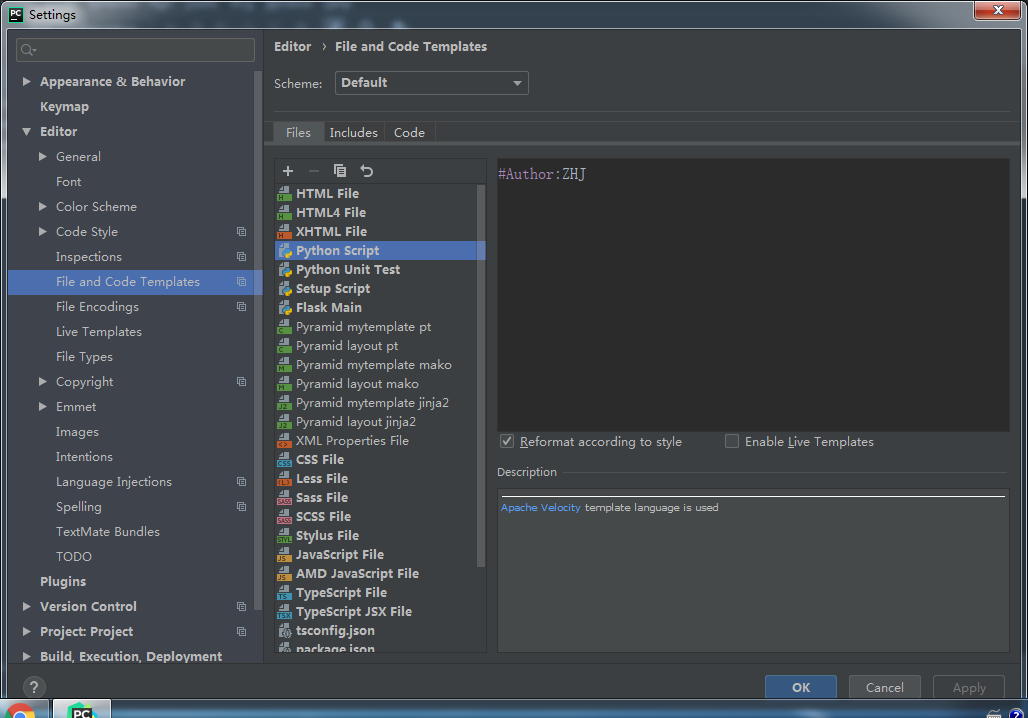
2、变量的内存管理
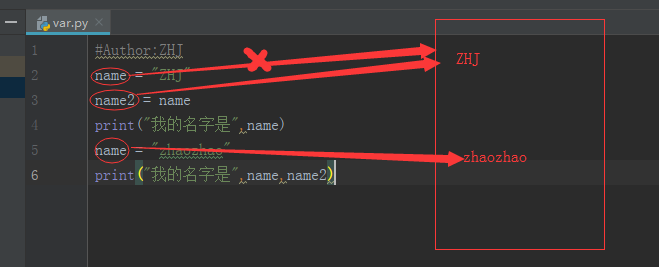
3、变量定义的规则
- 变量只能是字母、数字或下划线的任意组合
- 变量的第一个字符不能是数字
- 以下关键字不能声明为变量
['and', 'as', 'assert', 'break', 'class', 'continue', 'def', 'del', 'elif', 'else', 'except', 'exec', 'finally', 'for', 'from', 'global', 'if', 'import', 'in', 'is', 'lambda', 'not', 'or', 'pass', 'print', 'raise', 'return', 'try', 'while', 'with', 'yield']
三、字符编码的区别与介绍
1、python解释器在加载 .py 文件中的代码时,会对内容进行编码(默认ascill)
ASCII(American Standard Code for Information Interchange,美国标准信息交换代码)是基于拉丁字母的一套电脑编码系统,主要用于显示现代英语和其他西欧语言,其最多只能用 8 位来表示(一个字节),即:28 = 256,所以,ASCII码最多只能表示 255 个符号。
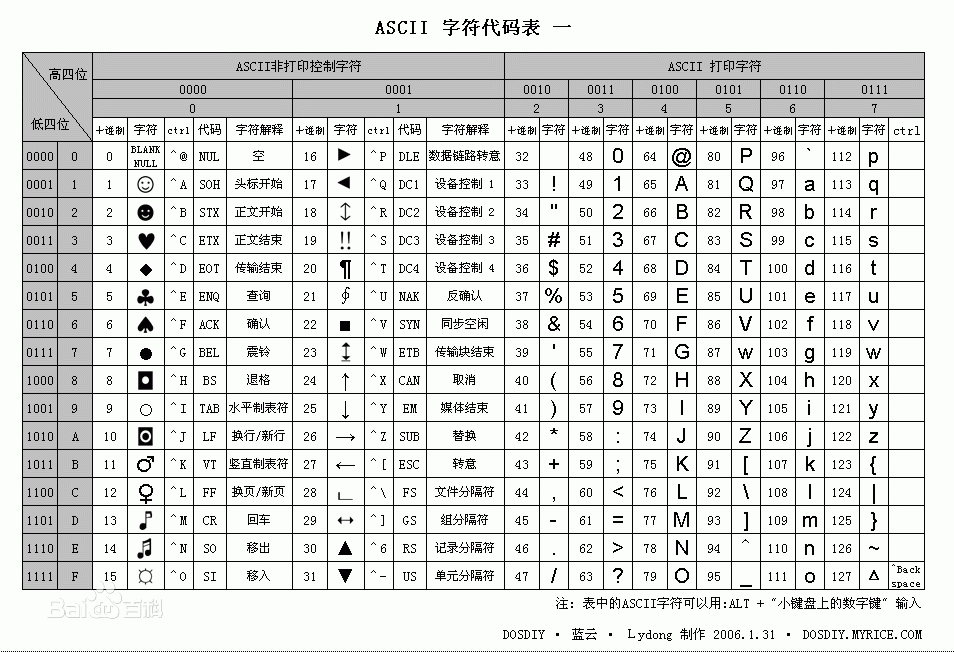
2、关于中文编码
简体中文的GB2312和用于繁体中文的big5
从ASCII、GB2312、GBK 到GB18030,这些编码方法是向下兼容的
3、国际编码
Unicode(统一码、万国码、单一码)是一种在计算机上使用的字符编码
UTF-8,是对Unicode编码的压缩和优化,他不再使用最少使用2个字节,而是将所有的字符和符号进行分类:ascii码中的内容用1个字节保存、欧洲的字符用2个字节保存,东亚的字符用3个字节保存
4、# -*- coding: utf-8 -*-
python 2.x上写中文要告诉解释器编码格式
python 3.x支持unicode编码
四、用户输入及格式化输出
1、注释
单行注释:#号后面跟要注释的内容
多行注释:'''被注释内容''' 三个单引号或双引号都可以
多行注释可以用来打印多行,如下图,左侧为源码,右侧为输出
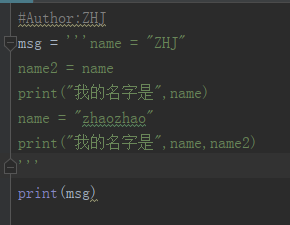
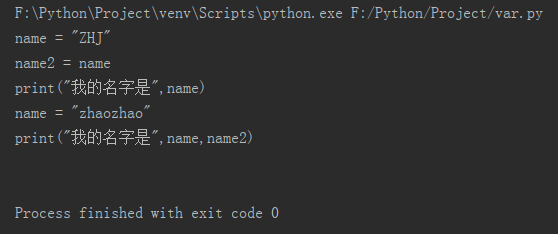
2、用户输入
1 username = input("请输入用户名")
2 password = input("请输入密码")
3 print(username,password)3、格式化输出
用+号拼接字符串,不建议使用,占用内存多
1 name = input("请输入用户名")
2 age = input("请输入年龄")
3 info = '''
4 ----------info of '''+name+'''----------
5 name:'''+name+'''
6 age:'''+age
7 print(info)用%s或%d或f%,%s是接收字符串的,%d是接收数值的,%d是接收浮点。input输入的均为字符串,所有在用%d时,必须用int()强制类型装换为整型
1 name = input("请输入用户名")
2 age = input("请输入年龄")
3 info = '''
4 ----------info of %s----------
5 name:%s
6 age:%s
7 '''%(name,name,age)
8 print(info)使用format格式化输出
1 name = input("请输入用户名")
2 age = input("请输入年龄")
3 info = '''
4 ----------info of {_name}----------
5 name:{_name}
6 age:{_age}
7 '''.format(_name=name,_age= age)
8 print(info)使用format格式化输出另一种
1 name = input("请输入用户名")
2 age = input("请输入年龄")
3 info = '''
4 ----------info of {0}----------
5 name:{0}
6 age:{1}
7 '''.format(name,age)
8 print(info)
五、if else流程判断
1、密文输入
导入标准库import getpass。这个在pychar中没效果,用命令行就可以实现
1 import getpass
2 name = input("请输入用户名")
3 age = getpass.getpass("请输入年龄")
4 info = '''
5 ----------info of {0}----------
6 name:{0}
7 age:{1}
8 '''.format(name,age)
9 print(info)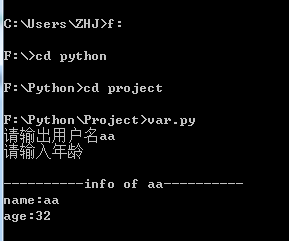
2、if语句基本结构
1 _username = "zhaojun"
2 _password = "123"
3 username = input("请输入用户名:")
4 password = input("请输入密码:")
5
6 if _username == username and _password == password:
7 print("welcome {name} login...".format(name = _username))
8 else:
9 print("invalid username or password")3、if elif语句 猜数字
1 _number = 33
2 number = int(input("猜数字:"))
3
4 if number == _number:
5 print("恭喜你,猜对了!")
6 elif number > _number:
7 print("猜大了!")
8 else:
9 print("猜小了!")
六、while循环
1、while循环,改进循环猜数字3次
1 _number = 33
2 count = 0
3 while count<3:
4 number = int(input("猜数字:"))
5 if number == _number:
6 print("恭喜你,猜对了!")
7 break
8 elif number > _number:
9 print("猜大了!")
10 else:
11 print("猜小了!")
12 count +=12、while else。改进三次后提示猜次数过多
1 _number = 33
2 count = 0
3 while count<3:
4 number = int(input("猜数字:"))
5 if number == _number:
6 print("恭喜你,猜对了!")
7 break
8 elif number > _number:
9 print("猜大了!")
10 else:
11 print("猜小了!")
12 count +=1
13 else:
14 print("已经猜了三次了,再见!")3、猜数字任性玩改进
1 _number = 33
2 count = 0
3 while count<3:
4 number = int(input("猜数字:"))
5 if number == _number:
6 print("恭喜你,猜对了!")
7 break
8 elif number > _number:
9 print("猜大了!")
10 else:
11 print("猜小了!")
12 count +=1
13 if count == 3:
14 confirm = input("你是否继续猜数字?按回车重新开始,按n为退出")
15 if confirm != "n":
16 count = 0
七、for循环
1、基本语法
1 for i in range(10):
2 print("loop",i)2、用for循环改进猜数字
1 _number = 33
2 for i in range(3):
3 number = int(input("猜数字:"))
4 if number == _number:
5 print("恭喜你,猜对了!")
6 break
7 elif number > _number:
8 print("猜大了!")
9 else:
10 print("猜小了!")
11 else:
12 print("已经猜了三次了,再见!")3、range里面的参数分别为,最小值,最大值,步长
1 for i in range(0,10,1):
2 print("loop",i)
八、课后作业
1、作业二:编写登陆接口
- 输入用户名密码
- 认证成功后显示欢迎信息
- 输错三次后锁定
在代码目录建立三个文本文件如下(最后一个字符串要带换行,因为前几行都有换行,为了比较时好比较,也就给最后一个加换行):
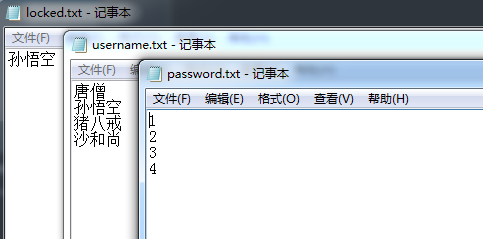
程序流程图:

代码:
1 # 是否锁定标志
2 is_locked = 0
3 # 登录三次计数
4 count = 0
5 #用户名是否存在标志
6 user_exist = 0
7 num = 0
8 while count<3:
9 print("----------请登录----------")
10 username = input("请输入用户名:")
11 password = input("请输入密码:")
12 count+=1
13 locked_file = open("locked.txt", "r")
14 locked_list = locked_file.readlines()
15 for i in range(len(locked_list)):
16 if username + "\n" == locked_list[i]:
17 is_locked = 1
18 break
19 if is_locked == 0:
20 locked_file.close()
21 user_file = open("username.txt", "r")
22 user_list = user_file.readlines()
23 for i in range(len(user_list)):
24 if username+"\n" == user_list[i]:
25 user_exist = 1
26 num = i
27 break
28 if user_exist == 1:
29 user_file.close()
30 pass_file = open("password.txt", "r")
31 pass_list = pass_file.readlines()
32 if password + "\n" == pass_list[num]:
33 pass_file.close()
34 print("恭喜,登录成功!")
35 break
36 else:
37 pass_file.close()
38 print("密码错误!")
39 continue
40 else:
41 user_file.close()
42 print("用户名不存在,请从新输入!")
43 else:
44 locked_file.close()
45 print("用户被锁定,请联系管理员解锁!")
46 else:
47 locked_file = open("locked.txt", "a")
48 locked_file.write(username+"\n")
49 locked_file.close()
50 print("输入超过三次,用户被锁定!")
- 三级菜单
- 可依次选择进入各子菜单
- 所需新知识点:列表、字典
程序流程图:
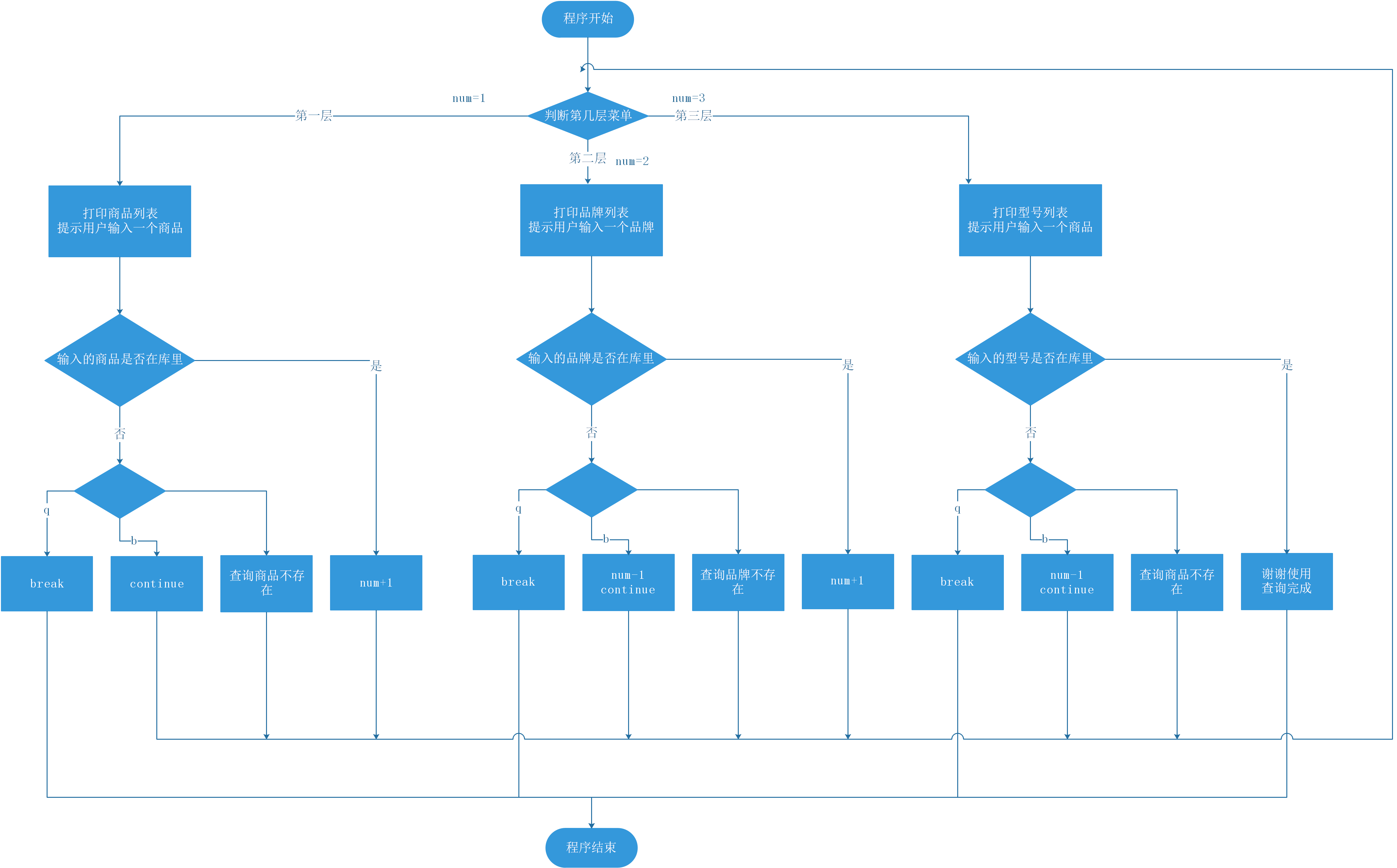
代码:
1 #Author:ZHJ
2 phone_model_huawei = {
3 "Mate30系列":""
4 ,"nova 5 Pro系列":""
5 ,"畅享9系列":""
6 }
7 phone_model_apple = {
8 "iPhone 11系列":""
9 ,"iPhone X系列":""
10 ,"iPhone 8系列":""
11 }
12 phone_model_samsung = {
13 "GALAXY Note 10系列":""
14 ,"GALAXY Note 9系列":""
15 ,"GALAXY S8系列":""
16 }
17
18 computer_modle_lenove = {
19 "启天M415系列":""
20 ,"扬天T4900d系列":""
21 ,"擎天T510A系列":""
22 }
23 computer_modle_dell = {
24 "成铭 3980MT系列":""
25 ,"Inspiron 灵越 3670系列":""
26 ,"Vostro 成就 3670系列":""
27 }
28 computer_modle_hp = {
29 "光影精灵系列":"",
30 "暗影精灵5系列":"",
31 "战99 Pro G1 MT系列":""
32 }
33
34 phone_brand = {
35 "华为":phone_model_huawei,
36 "苹果":phone_model_apple,
37 "三星":phone_model_samsung
38 }
39 computer_brand = {
40 "联想":computer_modle_lenove,
41 "戴尔":computer_modle_dell,
42 "惠普":computer_modle_hp
43 }
44
45 commodity = {
46 "手机":phone_brand,
47 "电脑":computer_brand
48 }
49
50 num = 1
51 input_commodity = ""
52 input_brand = ""
53 input_modle = ""
54 while True:
55 if num == 1:
56 print("----------请输入要查询的商品----------")
57 print(list(commodity.keys()))
58 input_commodity = input("请选择一个商品:")
59 if input_commodity in commodity:
60 num += 1
61 elif input_commodity =="q":
62 break
63 elif input_commodity =="b":
64 continue
65 else:
66 print("查询商品不存在,请重新输入!")
67 continue
68 elif num == 2:
69 print("----------请输入要查询的品牌----------")
70 print(list(commodity.get(input_commodity).keys()))
71 input_brand = input("请选择一个品牌:")
72 if input_brand in commodity.get(input_commodity):
73 num += 1
74 elif input_brand =="q":
75 break
76 elif input_brand =="b":
77 num-=1
78 continue
79 else:
80 print("查询品牌不存在,请重新输入!")
81 continue
82 elif num == 3:
83 print("----------请输入要查询的型号----------")
84 print(list(commodity.get(input_commodity).get(input_brand).keys()))
85 input_modle = input("请选择一个型号:")
86 if input_modle in commodity.get(input_commodity).get(input_brand):
87 print("----------**********----------")
88 print("谢谢使用,查询完成!")
89 print("----------**********----------")
90 break
91 elif input_modle =="q":
92 break
93 elif input_modle =="b":
94 num-=1
95 continue
96 else:
97 print("查询品牌不存在,请重新输入!")
98 continue
来源:oschina
链接:https://my.oschina.net/u/4291623/blog/3370420